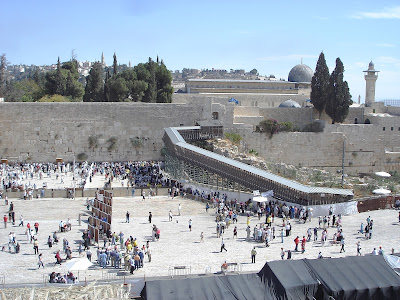 |
| Damascus Gate, Old City of Jerusalem |
There are slightly darker sides to this story, of course; the obliteration of Palestinian connection to the old city in media reportage of this "syndrome" is near total. Neither the Wiki article on the topic nor any of its references even mention the word "Palestine" in describing this fever taking place, while the Israeli Ministry of Foreign Affairs is listed as author on an article in the Jewish Virtual Library on the topic. Academic writing on the topic has come entirely from Israeli authors; Dr Yair Bar-El, who classified the syndrome into three separate levels of psychosis based on previous mental health and religiosity, was a former director of Kfar Shaul Mental Health Centre, which deals with all cases of the syndrome - and which was built in the ruins of ethnically-cleansed Deir Yassin.
The honourable exception is Haaretz, which compared the insanity of individuals suffering the syndrome to the holy war being waged by the Israeli government to legitimise their control of the city. Despite the fact that East Jerusalem, like the rest of the Occupied Palestinian Territories, is an occupied territory, the Israeli state exercises full military and civil authority over it (while denying residents the right to vote). In 1980 the Israeli Knesset passed a law declaring Jerusalem united and the capital of Israel, which was rejected by UN Security Council Resolution 478. But the theft of East Jerusalem was already well underway. From the moment of occupation in 1967, Israel set in place a long term plan to rewrite "facts on the ground" with massive settlement in areas surrounding East Jerusalem. Administrative boundaries, which had been set under the partition plan, were unilaterally redrawn by Israel in 1967 to include "“NO AREA” for future Arab Jerusalemite development":
The new boundaries of the City were delineated for security and demographic considerations and in order to create geographic integrity and demographic superiority for the Jewish population in Jerusalem. In order to accomplish this, the redrawing of Jerusalem municipal boundaries excluded the densely populated Palestinian communities (the residences but not the lands) in the north, including Beit Iksa and Beir Nabala, whereas the sparsely populated communities’ lands in the south were included (Bethlehem and Beit Sahour)
 |
| Settlements east of Jerusalem |
Today, the East Jersualem suburbs of Sheikh Jarrah and Silwan frequently flare up in protests against housing demolitions.
There is a still darker side to the Jerusalem syndrome, and the narratives of "holy war" which use religiosity to justify oppression. An example of this is Denis Michael Rohan, an Australian tourist who attempted to set fire to the al-Aqsa mosque in 1969. He had previously worked on a Kibbutz in Israel, and was attempting to destroy the mosque in order to enable the biblical Temple to be rebuilt. For some, the political "holy war" should be waged biblically.
 |
| Western Wall and the al-Aqsa Mosque |
Perhaps the breath-snatching surreal feeling I had the whole time I spent in East Jerusalem is a form of the syndrome, too. Even for a firmly non-religious person like myself, there is something overwhelming about the Holy City. It's a feeling I took with me everywhere in Palestine, which at times nearly brought me to tears. I found it immensely jarring to be walking the old city's cobbled streets looking for a reasonably priced laundromat! Every movement, every place, every word somehow seemed heavier than it would in Australia, more laden with significance.
To me, it's the weight of human history, moreso than the religious assocations, which make Jerusalem (and Palestine) such a singular place. For thousands of years, untold lives have been sacraficed to control a single square kilometre of land. It's been destroyed twice, besieged 23 times, attacked 52 times, and captured and recaptured 44 times. Now, that weight of history and significance bears down on the residents of the old city; both those Israelis who see themselves as chosen people, and their attempts to cleanse the land as mandated by God, and the Palestinians, who with characteristic sumoud (steadfastness), refuse to buckle under the weight of discriminatory Israeli policies.

No comments:
Post a Comment